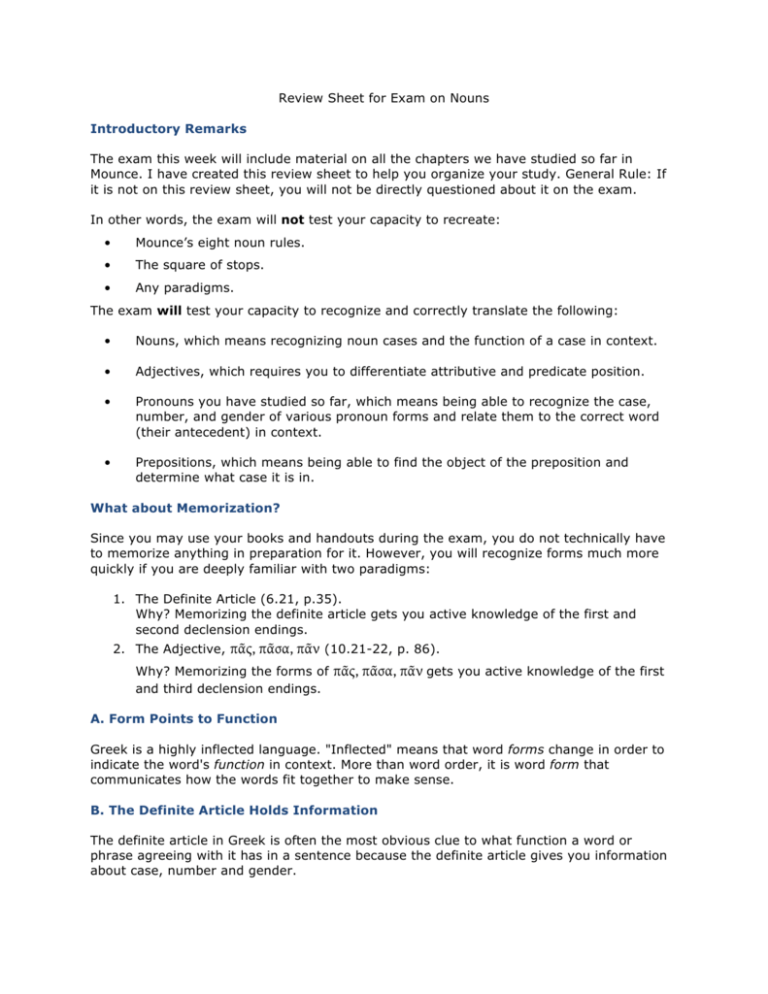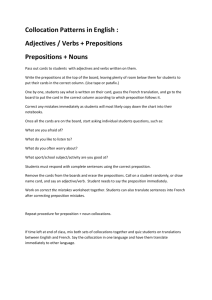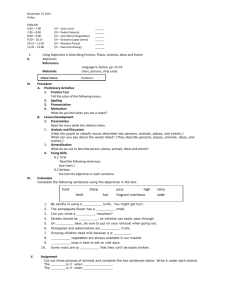πᾶς, πᾶσα, πᾶν (10.21-22, p. 86).
advertisement

Review Sheet for Exam on Nouns Introductory Remarks The exam this week will include material on all the chapters we have studied so far in Mounce. I have created this review sheet to help you organize your study. General Rule: If it is not on this review sheet, you will not be directly questioned about it on the exam. In other words, the exam will not test your capacity to recreate: • Mounce’s eight noun rules. • The square of stops. • Any paradigms. The exam will test your capacity to recognize and correctly translate the following: • Nouns, which means recognizing noun cases and the function of a case in context. • Adjectives, which requires you to differentiate attributive and predicate position. • Pronouns you have studied so far, which means being able to recognize the case, number, and gender of various pronoun forms and relate them to the correct word (their antecedent) in context. • Prepositions, which means being able to find the object of the preposition and determine what case it is in. What about Memorization? Since you may use your books and handouts during the exam, you do not technically have to memorize anything in preparation for it. However, you will recognize forms much more quickly if you are deeply familiar with two paradigms: 1. The Definite Article (6.21, p.35). Why? Memorizing the definite article gets you active knowledge of the first and second declension endings. πᾶς, πᾶσα, πᾶν (10.21-22, p. 86). Why? Memorizing the forms of πᾶς, πᾶσα, πᾶν gets you active knowledge of the first 2. The Adjective, and third declension endings. A. Form Points to Function Greek is a highly inflected language. "Inflected" means that word forms change in order to indicate the word's function in context. More than word order, it is word form that communicates how the words fit together to make sense. B. The Definite Article Holds Information The definite article in Greek is often the most obvious clue to what function a word or phrase agreeing with it has in a sentence because the definite article gives you information about case, number and gender. Week 5 (Fall 2012) 2 When you memorize the forms of the definite article, you are actually memorizing most of the endings used in First and Second Declensions. The feminine form of the definite article parallels the First Declension endings; the masculine and neuter forms of the definite article parallel the Second Declension endings. KNOW forms of the definite article. If you need to find them quickly during your study, they are on the laminated sheet on the left side of the front page, just under the alphabet. C. "Case" Matters Nouns never change declensions or gender. They do change case. Case gives you clues to how nouns, adjectives and pronouns are functioning. Nominative Case • • For subjects of sentences and clauses. For predicate nouns and adjectives (i.e., those nouns and adjectives that follow a "being" verb). Genitive Case – "of" or "from" may help to translate. • • • • Gives description. Indicates possession. Indicates origin or separation. For the object of some prepositions (often indicating movement away from). Dative Case — “to,” “for” or “in” may help to translate. • • • For indirect object (use “to” or “for”). Indicates location (“in”). For the object of some prepositions (often indicating stationary location, rather than movement). Accusative Case • • • For the direct object of a sentence. Indicates movement toward, around, or alongside. For the object of some prepositions (often indicating movement toward). Vocative Case • Exclusively for direct address ("Brothers and sisters, I greet you.") Its form is often identical to the nominative. KNOW these common functions of the cases. If you need to find these functions quickly Week 5 (Fall 2012) 3 during your study, refer to the mind map of the Greek noun. To read more about them, consult Biblical Greek: A Compact Guide, pp. 2530. D. Adjectives An adjective modifies a noun, pronoun, or another adjective. Attributive and predicate adjectives agree in case, number, and gender with the word they modify. Substantive adjectives do not modify another word in the sentence. Their case is determined by their function in the sentence (substantive adjectives functioning as subjects are in nominative case; substantive adjectives functioning as direct objects are in the accusative case, etc.). A substantive’s number and gender are determined by what they stand for (a group of things would be plural, neuter; one woman would be singular, feminine, etc.). Adjectives function in one of three ways: 1. Attributive adjectives describe an attribute of the thing they are modifying (a noun, a pronoun, or sometimes another adjective). a. ὁ καλός διδάσκαλος The adjective ascribes the attribute “good” to the teacher. 2. Predicate adjectives assert something about the subject of the sentence. a. καλός ἐστίν ὁ διδάσκαλος The adjective finishes the thought of the sentence: the teacher is good. By the way, the definite article before “teacher” tells you it is the subject of the sentence. 3. Substantive adjectives function the way nouns or pronouns would in the same place. a. oἱ πίστοι πιστεύσιν τόν λόγον. The faithful people (or “faithful ones”) are believing the word. KNOW how to recognize adjectives in attributive and predicate position and translate them appropriately. To recall how to differentiate attributive, predicate and substantive adjectives based on their appearance in a sentence, review the material in Mounce’s Biblical Greek: A Compact Guide, pp. 18-19, “Identification.” E. Pronouns Antecedent = the word that a pronoun stands for. “Jim caught the ball after it left Julie’s bat.” The antecedent of “it” is ball. A pronoun agrees in number and gender with its antecedent but NOT necessarily in case. A pronoun’s case is determined by the pronoun’s function in the sentence. The forms of the pronouns you know so far are on Mounce’s laminated sheet in the upper left corner of the second page. Week 5 (Fall 2012) 4 I don’t care at all that you know that τις is called an “indefinite pronoun.” I do care that you know τις means “a certain person.” In other words, you do not need to identify the type of pronoun you are looking at in grammatical terms. You do need to be able to translate it. KNOW how to determine the case, number, and gender of a pronoun, find its antecedent, identify its function in a sentence, and translate it properly in context. F. Prepositions Prepositions identify relationships between two words. The relationship they identify can be related to space (over, under, alongside, etc.) or time (before, after, etc.) Your handouts on prepositions (the lion pictures and house picture), as well as Mounce’s circle on the laminated sheet, p. 1, will help you review prepositions. Preposition grammar: 1. Prepositions do not change form, except for minor spelling changes related to pronunciation (such as when the following word begins with a vowel). 2. Prepositions do not appear in a case. (Their objects do appear in a case.) 3. The case of the object of a preposition determines what the preposition means. This is why you memorize a case along with a meaning for each preposition in the vocabulary list. KNOW how to translate prepositional phrases. G. Translation Tips Breaking a longer sentence into smaller parts can help you with translation. 1. Remember that these words do not begin a clause in Greek, but their translation does begin the clause in English. The words are called “postpositives.” The sense unit begins with the word just before one of these: a. δέ b. οῦν c. γάρ 2. Split a sentence in these places and then proceed to translate. a. Before conjunctions like καὶ and ἀλλὰ. b. Before prepositions, translating the prepositional phrase as a unit. c. After punctuation like commas or semicolons. d. Before small words that begin a clause, words such as: ὅτι and ἵνα. e. Before relative pronouns, keeping the relative clause together as a unit (see Mounce, BBG, 14.12-14.13). Week 5 (Fall 2012) 5 Example of phrasing: Let’s say this sentence is on the exam. To translate it, break it into units, then take one unit at a time. ἔρχεται οὖν πρὸς Σίμωνα Πέτρον· λέγει αὐτῷ· κύριε, σύ μου νίπτεις τοὺς πόδας; Stop at the preposition, πρὸς, then translate what precedes it. ἔρχεται (he/she/it comes) οὖν Then he comes Keep the prepositional phrase together; stop at the semicolon. πρὸς Σίμωνα Πέτρον· to Simon Peter Stop at punctuation. λέγει αὐτῷ· he says to him, Stop at punctuation. κύριε, “Lord, Stop at punctuation. σύ μου νίπτεις (you are going to wash) τοὺς πόδας; are you going to wash my feet?” I will not ask you to phrase a sentence before you translate it. This exercise is just intended to illustrate what I mean by “phrasing” and how it might help you translate.







